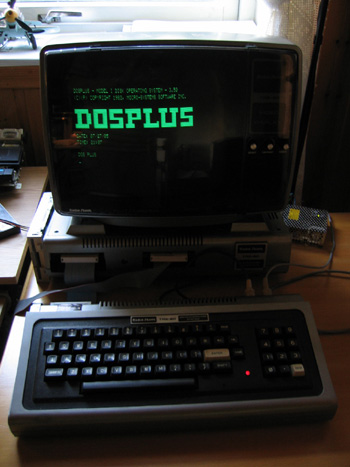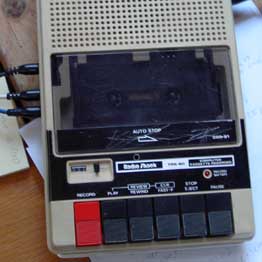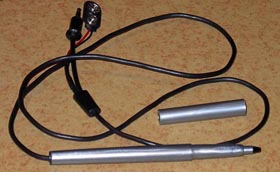 |
|
This is my first TRS-80 Microcomputer (it was called Model I when Model II came out) it is Level 2 with 16K RAM, 26-1003D.
It has lowercase, and the buffer mod. Something bad must have happened to the keyboard since some keys are replaced and the keypad is removed. Anyway, all the present keys worked as opposed to the Model III and 4.
I got 2 EIs with it. The first (the one in the picture) 26-1140-1 has
32K extra RAM, the buffer mod and the buffer cable. It is the older
one, and
doesn't fit with the EI schematics I have. The second one 26-1140 also
has 32K extra RAM and the RS-232 card. It doesn't have the buffer mod
and
doesn't need it, it is the one I'm using. It fits the schematics. There
was also one Tandy double density card. It is now mounted in the second
EI, the one I use. Have a look at my page about The Expansion Interface
It also came with an original screen, 26-9201, which unfortunately has a little screenburn. The screenburn isn't too bad, you only see it when it is turned off. It is otherwise in a good shape, probably not much more fuzzy than it used to be. And yes, this "fuzzograph" kind of hides the flicker that comes from screen RAM access, when compared to the crispy clear Philips monitor I use with the Video Genie.
There were 3 big floppy drives too. Two if them original Model I drives, 26-1160A and 26-1161A, both with Teac FD-50 drives inside. One doesn't work and the other works, but not very good. They are 35 track single sided. The third is a CoCo drive 26-3023 with an MPIO model 51 inside (I think 51 but the stamp is bad). It works well and is 40 track single sided. It is the one to the left in the picture above.
I now use it with two 3.5" drives. The configuration in the picture was my setup when transferring old 5.25" floppies. :0 and :1 was 3.5" while the CoCo drive was :2. I now use a Sony MPF520 and a Sony MPF920 (same brand because they look the same - esthetical) Some day I will make them a cabinet, together with the powersupply. Have a look at my floppydrive page.
 |
New arrivals, yes I have bought two more Model I's on eBay, another EI, several double density kits and a monitor. I often buy in the untested category, because I'm capable of repairing and the prices are lower. 1. EI from USA, 26-1142A, older type and without the buffer mod. Had 32K RAM and the RS-232 option, did work. 2. "Aussie" Model I 26-1001, all the way from Australia. 16K no keypad type. Set of two ROM's (not daughterboard). Cassette mod (XRX-3). Lowercase mod (strange). Didn't work out of the box, but the problem was only bad contact, ROM socket had to be cleaned thoroughly. For some reason it has 60Hz video. 3. ARC DD from UK, didn't work (and still doesn't). This is an odd one as it has a strange not completely compatible double density floppy controller. Doc's claim it can do 8" drives. 4. "Wigan", Model I 26-1006, also from UK. 16K with keypad. Set of two ROM's (not daughterboard). It had some repairable faults (broken Z80 and 2102 video RAM) but is now my main Model I with its full keyboard with keypad. 5. Aerocomp DD from USA. Didn't work either (now repaired) 6. Another Aerocomp DD, this time it worked. 7. A green RS Model I monitor 26-9202, from UK, really nice one and my main Model I monitor now. So all in all I have 2 nice complete Model I setups, one older and one newer, both with 48K, lowercase and DD. Only one with RS-232 though. For backup (worst case - spareparts) but working, one Model I and one EI. For the moment non working but waiting for repair are an original RS-232 card and ARC DD. I would like to thank Graeme Draper for the first TRS-80 (the
one in the top
picture) and
all the
equipment. |

